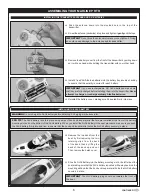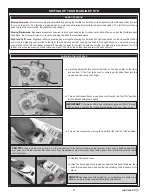
5
MARLIN EP RTR FAMILIARISATION
- Top Deck
2 - Motor Mount
3 - Motor
4 - Drive Shaft
5 - Battery Mounting Slot
6 - Radio Box
7 - Battery Plug
8 - Battery
9 - On/Off Switch
0 - Receiver Antenna
- Propeller
2 - Rudder
3 - Hatch Cover
2
3
4
6
5
7
8
9
0
2
Top Deck:
Moulded from lightweight, high-strength plastic, the top deck helps prevent water from getting into the hull.
Motor:
Provides power to the boat. The Marlin EP RTR features a powerful 540-size motor to reach high speeds.
Motor Mount:
Made of aluminium, the motor mount secures the motor to the hull.
Drive Shaft:
Connects from the motor to the propeller and features a universal connector for smooth operation.
Battery Plug:
The 6-Cell, 7.2v battery connects to this plug to power the motor and the electronics inside the boat.
Battery Mounting Slot:
This slot securely holds the 6-Cell battery. The slot can also accommodate a 7-Cell battery.
On/Off Switch:
Turns the electronics inside the boat on and off.
Radio Box:
Sealed with clear tape to help keep water out, the radio box houses the steering servo, ESC and receiver.
Receiver Antenna:
Receives the signals from the transmitter. Never cut the antenna shorter or you'll lose control of the boat after a
very short distance.
Rudder Steering Arm:
Mounted to the top of the rudder, the steering arm allows the rudder to pivot right and left.
Rudder:
The rudder pivots right and left to make the boat turn right and left.
Propeller:
The propeller is attached to the drive shaft. When spinning, the propeller creates thrust which pushes the boat forward.
TIPS FROM THE PROS
●
When installing the transmitter antenna, don't force the antenna into place or over-tighten it. Doing so could cause damage to the
antenna and/or transmitter.
●
The Ni-Cd battery is held in place using strips of hook and loop material. When you install the Ni-Cd battery, make sure you push
the Ni-Cd battery firmly into position, to ensure that the hook and loop material holds the Ni-Cd battery securely in place.
●
If you look closely at the receiver on/off switch, you'll notice that "On" and "Off" are moulded into the switch mounting plate.
●
If you have difficulty sliding the antenna wire through the antenna support tube, first pull the antenna wire through your fingers
several times to straighten it out, then lightly wet the antenna wire with glass cleaner. The glass cleaner will make the antenna wire
slide through the support tube much easier.
●
Always make sure you turn on the transmitter first, before turning on the receiver. After you've finished using your boat, turn off the
receiver first, then turn off the transmitter. This will prevent stray radio signals from interfering with the radio control system.
●
If the rudder can't be centred using the steering trim lever, grasp the rudder with your fingers and firmly turn it until it's centred.
●
Before charging the Ni-Cd battery, ensure that it is fully discharged. Discharge the Ni-Cd battery by running the motor until it stops.
This will ensure that you don't overcharge the Ni-Cd battery.
●
When the Ni-Cd battery in the boat begins to run low, the boat will slow down drastically in a very short period of time. When this
happens, immediately return the boat to shore so it doesn't completely run out of power in the middle of the lake.
3






























